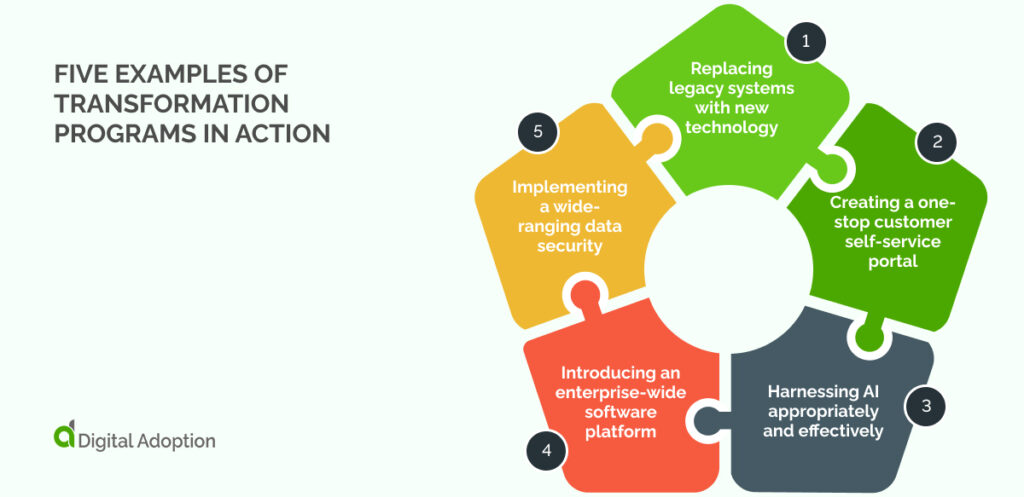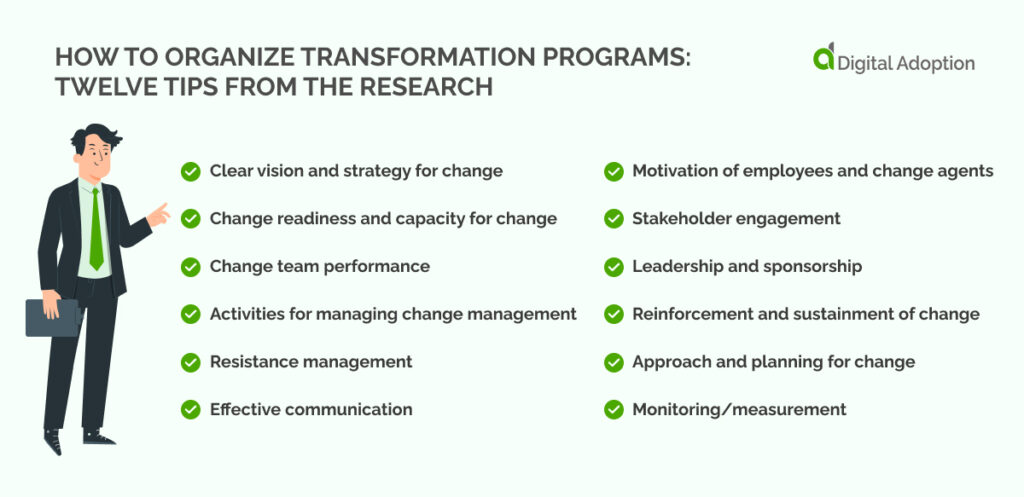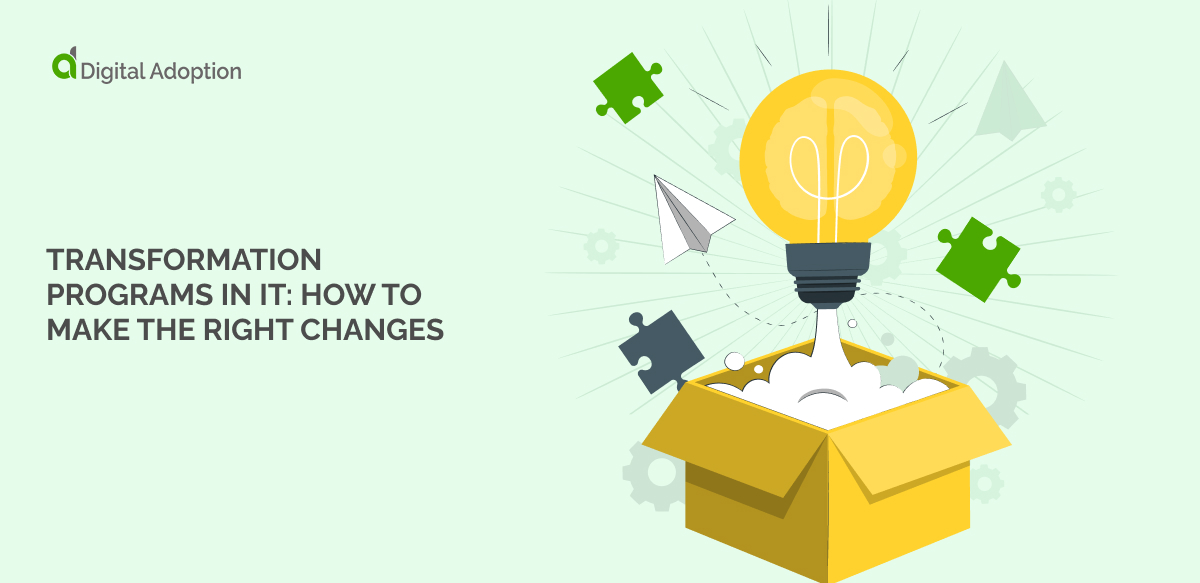“Transformation” is a powerful word.
It evokes excitement but also carries a hint of fear. Any type of transformation holds the potential to bring prosperity, happiness, and profitability to an organization.
However, beneath the surface of this transformative journey, a subtle threat lingers that things may not unfold as planned.
That’s why you must be careful about transformation programs in any organization. Whereas organizational evolution happens naturally, transformation programs will take place in a relatively short space of time.
This article will introduce you to transformation programs in a business context.
With a particular focus on digital transformation programs, we will:
- Explain what the phrase “transformation program” means
- Introduce five key examples of transformation programs from the world of digital transformation
- Examine some research-based advice about avoiding significant problems in your change program.
Amidst rapid change, implementing a successful transformation program becomes a pivotal strategy to maintain a firm grasp on business success.
What Are Transformation Programs?
To get us started, we’ll outline some of the fundamental knowledge of transformation programs: the meaning of the term, their objectives, and the challenges they involve.
The meaning of transformation programs
In April 2023, a McKinsey analysis pointed out that “transformation has been a catchall term for how organizations make the right moves to achieve their full potential.”
In other words, a transformation program refers to how organizations can adapt to new circumstances: change initiatives, business transformation, digital transformation, organizational change, and more.
But if transformation programs come with risks and benefits, why do managers and leaders go through with them?
Transformation Programs: Common Objectives
Like any difficult decision, transformation programs are about good business: increasing revenue, improving profit margins, and reducing costs.
A transformation program may target some more specific areas. For example:
- To improve customer experiences
- To reduce the number of staff employed
- To make more sales
- To appeal to a different portion of the market
- To continue to meet demand while scaling
The good news is that “transformation” doesn’t simply entail “terminating all your employees.” In the 2020s, businesses are adapting to keep pace with significant shifts in commerce.
Transformation projects sometimes have a bad reputation. Transformation efforts won’t magically fix all of the problems in your organization. And if your preparation is inadequate, they might cause you a lot of fuss (without much in the way of a return).
Fortunately, analysts are already familiar with some major challenges in today’s business environment.
Common Challenges for Transformation Programs
The challenges for transformation programs come as a surprise to newbie transformation agents. However, if you ask some experienced transformation agents, they will tell you these challenges are not new.
The following challenges are common across various transformation programs:
- Human resistance to change. If your drivers have been using paper to sign out their deliveries for years, how will they feel about using a tablet?
- Poor communication. If you didn’t tell everyone that the new HR system was going live next Wednesday, can you be surprised that no one is using the new software on Thursday?
- Insufficient training. Transformation programs will often make processes simpler. However, there is a period of adaptation where front-line employees are getting used.
- Rapid roll-out. When you’ve discovered a brilliant solution to an old problem, rapidly rolling the whole thing may be tempting. It’s important to leave enough time to address the challenges of transformation programs.
- Unintended consequences. Quick changes may disrupt existing processes, creating unforeseen bottlenecks or inefficiencies.
It’s easy to see these problems when you look back on a failed project. But they’re very hard to predict!
The good news is that a clear strategic plan can be enough to secure the success of your project.
We will talk more about the ingredients of a successful project later in the article.
Five Examples of Transformation Programs in Action

Although “Transformation program” can refer to any kind of change project, we are limiting ourselves to digital transformation programs in this article.
Perhaps these are some of the most important change programs you’ll see in 2023.
So you’re thinking about transformation programs. What does it look like? What might it be?
Let’s check out five quick examples:
Replacing legacy systems with new technology
“Legacy system” can apply to many types of outdated technology.
It may be a move from outdated digital infrastructure to more efficient systems. But it might also involve a substantial shift from paper-based processes to computerized solutions.
Surprisingly, even as we enter the final stretch of 2023, some companies are still in the early stages of embracing full-scale cloud adoption.
This transformation endeavor presents an opportunity to harness the capabilities of cloud technology for enhanced scalability, flexibility, and data accessibility, and it is a crucial step for businesses to remain competitive and adaptable in the evolving digital landscape.
Transformation programs can be a great way to “start over” when it comes to older technology.
Creating a one-stop customer self-service portal
Today’s customers, whether they are individuals or businesses, have heightened expectations for seamless and efficient experiences.
Achieving this requires robust software solutions, thorough testing procedures, and seamless integration with a spectrum of services. Developing a comprehensive self-service portal empowers customers to access information, resolve issues, and perform transactions independently.
Such a transformation endeavor enhances customer satisfaction, streamlines operational processes, and strengthens the organization’s competitive edge by delivering the convenience and efficiency that modern customers demand.
Harnessing AI appropriately and effectively
IT leaders have been dealing with the challenges of rogue IT (also known as Shadow IT) for many years.
Now, there’s a new enemy in town: shadow AI. If you didn’t know, that’s how we talk about all the unauthorized AI applications that employees might use.
Many businesses will need a transformation process to bring AI on board quickly and effectively. It will take planning, risk management, and thoughtful decision-making to ensure that AI gives you a competitive advantage in the years to come.
Introducing an enterprise-wide software platform
Comprehensive software solutions like ERP (Enterprise Resource Planning), HRM (Human Resource Management), or CRM (Customer Relationship Management) packages are some of the most transformative technologies today. They can radically improve your business processes, rapidly returning business benefits across the organization.
However, introducing these packages can be a big deal, including updating existing systems, replacing outdated digital infrastructure, introducing entirely new functionalities, or a vendor switch.
The details involved in configuring, integrating, and deploying enterprise-wide software platforms underscore the non-trivial nature of this transformation effort, which, when executed effectively, can optimize business processes, enhance data management, and bolster the organization’s overall efficiency and competitiveness.
Implementing a wide-ranging data security
Data security can be a transformation program on its own. However, it should be on your radar whenever you introduce new digital technologies in your business.
This kind of transformation involves looking at and making better the rules and tools for keeping data secure. This includes using special codes to hide data, controlling who can access it, setting up systems to catch any threats, and teaching employees how to keep data safe.
The main goal is to strengthen the organization’s defenses against the many kinds of online threats and to follow the rules about data protection. This change is important but tough because it needs careful planning and ongoing work to deal with new threats. However, when done right, it reduces the risks of data breaches and makes customers and others trust the organization more.
How to Organize Transformation Programs: Twelve Tips From The Research

A successful transformation program can distinguish between success and failure in today’s competitive market. But how can you ensure your digital transformation program gives you everything you hoped for?
To put it simply, you need a digital transformation strategy. There are so many ways to organize digital transformation projects – and many tried-and-tested change management models would work very well.
But the good news is that business researchers from Morocco have compared all these models and discovered 12 crucial success factors to improve things.
They outlined the 12 most crucial factors in the success of transformation programs:
1. Clear vision and strategy for change
2. Change readiness and capacity for change
3. Change team performance
4. Activities for managing change management
5. Resistance management
6. Effective communication
7. Motivation of employees and change agents
8. Stakeholder engagement
9. Leadership and sponsorship
10. Reinforcement and sustainment of change
11. Approach and planning for change
12. Monitoring/measurement
We’d be lying if we said it was simple.
However, it’s heartening to know that the ingredients of a successful transformation are all there. If you have a project transformation office set up, they can make sense of these challenging priorities.
To get a clearer idea of how to improve your transformation, you can look at some sector-specific guidance. And on this site, we have a lot of relevant articles! For example, see these articles:
- Digital transformation programs for financial businesses
- Transformation programs for the procurement process
- Educational transformation programs
- Business digital transformation for the airline industry
Get set for a successful transformation project
Over the past year, we have witnessed remarkable advancements in the realm of digital technologies and global events. These developments have brought about significant changes, impacting various aspects of our lives.
For those fortunate enough to have remained unaffected by these changes, it is important to recognize the opportunities they present. However, for the rest of us, it is time to contemplate the scope of our transformation program and embrace the possibilities that lie ahead.
As we have observed, achieving success in the face of these transformations is not akin to rocket science. It requires a thoughtful approach and a clear strategy. Start by formulating a comprehensive plan that considers your industry’s unique challenges and opportunities. Seek sector-specific insights on transformation, understand the trends and emerging technologies, and identify the potential hurdles that lie ahead.
With a solid foundation in place, you will be prepared to rally your team and garner their support for the impending change. Engage them in the process, communicate the vision, and demonstrate the benefits that the transformation will bring. Together, you can navigate the complexities of this ever-changing landscape and emerge stronger and more resilient.
Remember, the path to success may not always be easy. But with the right mindset and a proactive approach, you can transform challenges into opportunities and drive meaningful change in your organization.
Embrace the journey and let the winds of transformation propel you towards a brighter future.




![18 Examples of AI in Finance [2025]](https://www.digital-adoption.com/wp-content/uploads/2025/06/18-Examples-of-AI-in-Finance-2025-300x146.jpg)
![14 Examples of AI in Manufacturing [2025]](https://www.digital-adoption.com/wp-content/uploads/2025/06/14-Examples-of-AI-in-Manufacturing-2025-300x146.jpg)
![29 Examples of AI in Education [2025]](https://www.digital-adoption.com/wp-content/uploads/2025/06/29-Examples-of-AI-in-Education-2025-300x146.jpg)
![15 Examples of AI in Retail [2025]](https://www.digital-adoption.com/wp-content/uploads/2025/06/15-Examples-of-AI-in-Retail-2025-300x146.jpg)
![13 Examples of AI in Healthcare [2025]](https://www.digital-adoption.com/wp-content/uploads/2025/06/AI-in-healthcare-examples-300x146.jpg)


![18 Examples of AI in Finance [2025]](https://www.digital-adoption.com/wp-content/uploads/2025/06/18-Examples-of-AI-in-Finance-2025.jpg)
![14 Examples of AI in Manufacturing [2025]](https://www.digital-adoption.com/wp-content/uploads/2025/06/14-Examples-of-AI-in-Manufacturing-2025.jpg)
![29 Examples of AI in Education [2025]](https://www.digital-adoption.com/wp-content/uploads/2025/06/29-Examples-of-AI-in-Education-2025.jpg)